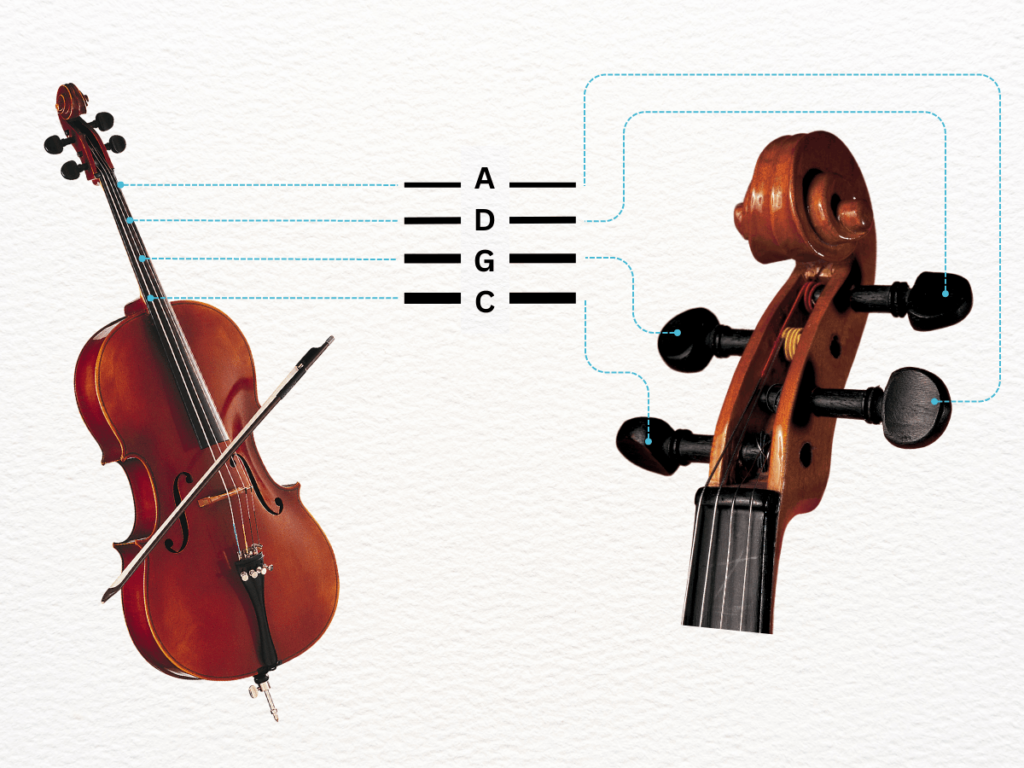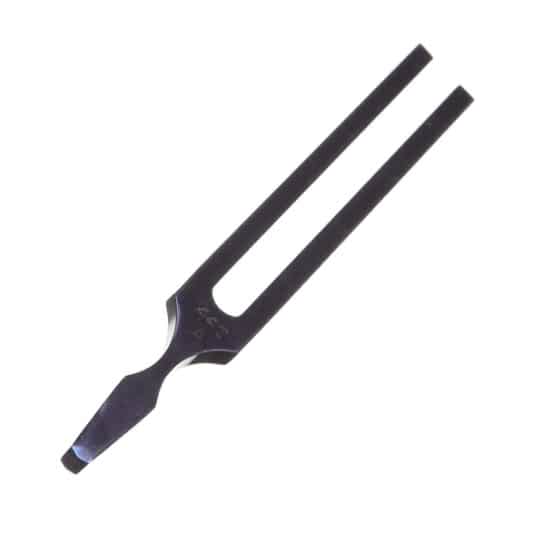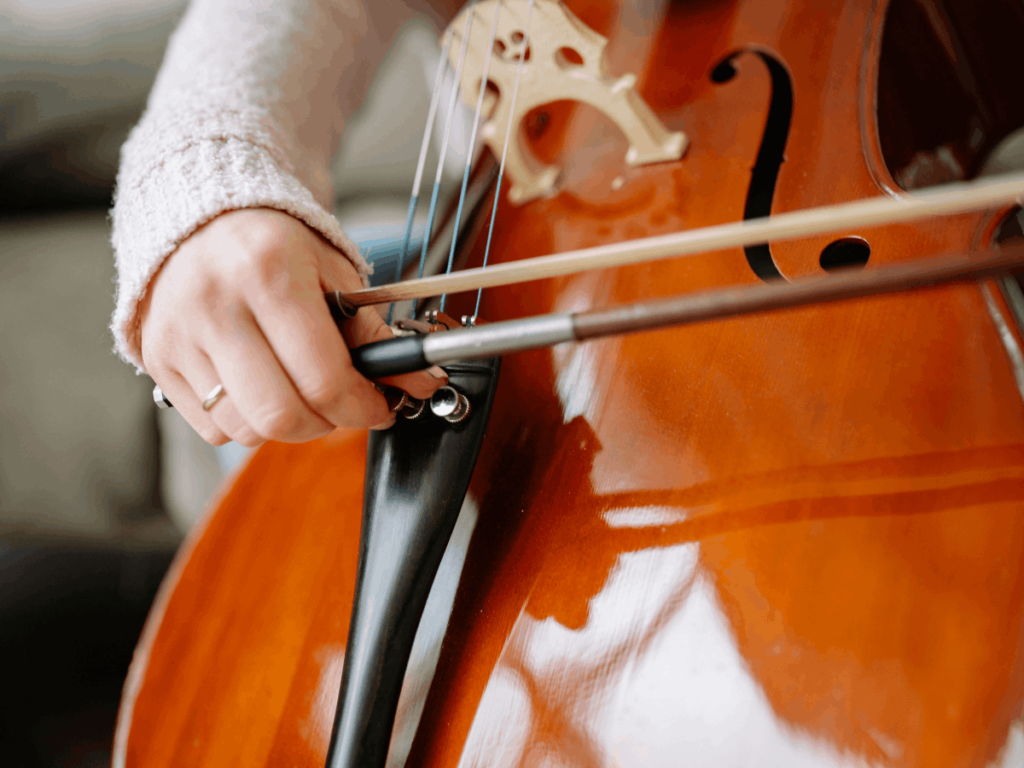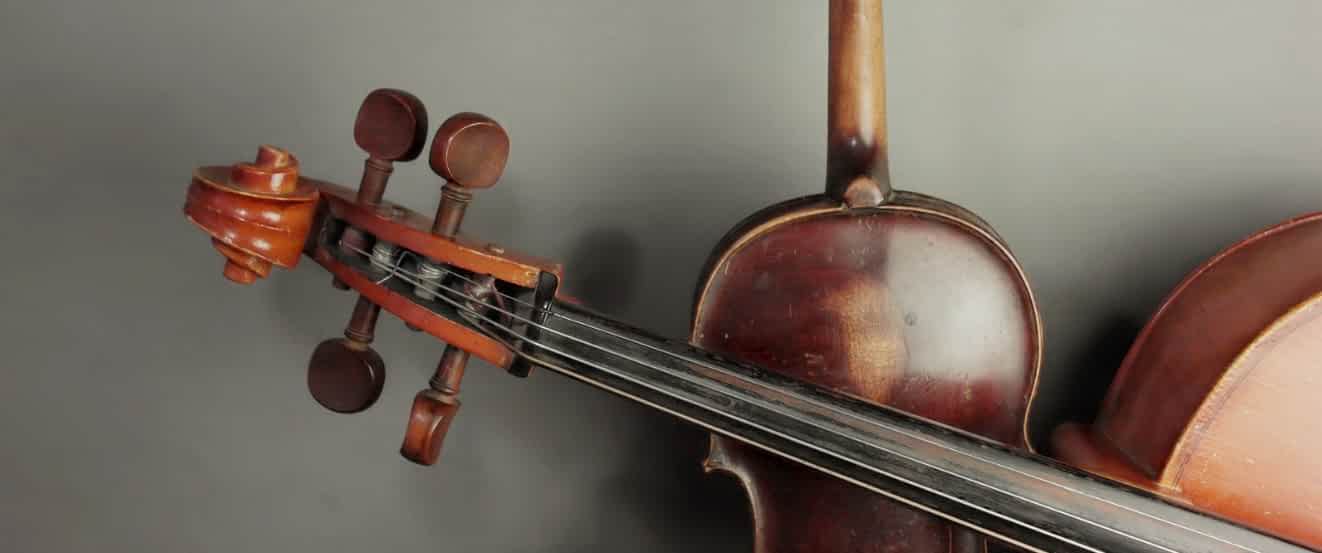Discover **all the hacks** to get your cello perfectly in tune. Learn how to make each string sing in harmony, explore advanced techniques, and uncover hidden pro tips from experts.
It’s something that every cellist has to learn. So let’s get it done and dusted…
Understanding Cello Strings and Their Tuning
The cello is a string instrument that consists of four strings: C, G, D, and A, which are tuned in perfect fifths.
As one of the most popular string instruments, the customary tuning sequence for cello strings is C, G, the D string, and A, with the objective being to ensure a seamless transition when adjusting the tuning pegs and achieving the correct pitch for each string.

Tuning pegs, located at the head of the instrument, are used to adjust the strings and produce the desired pitch, while fine tuners at the tailpiece help adjust the tension of the corresponding string to slightly nudge the pitch up or down.
Using a cello tuner, such as a digital tuner or tuning fork, can be highly beneficial in achieving accurate tuning and refining intonation.
Essential Tools for Cello Tuning
To tune a cello effectively, it’s handy to have a few things, including tuning pegs, fine tuners, digital tuners, and tuning forks.
Some people also use pitch pipes; but I think they’re just hassle.
Each tool plays a crucial role in the tuning process, allowing for precise adjustments and accurate tuning of your cello strings.
In the following subsections, I will explore digital tuners and apps, as well as tuning forks and pitch pipes, and how they contribute to successful cello tuning by ensuring the peg box is properly adjusted.
Digital Tuners and Apps
Digital tuners and apps are valuable tools for precise cello tuning, offering visual guidance and easy-to-use interfaces for musicians of all levels.
Popular cello tuner apps include Tonal Energy, Cleartune, and Tunable, each providing unique features and benefits to help you achieve the correct pitch for your cello strings.
One such feature, found in the Tonal Energy app, is a bright green smiley face that appears when a note is played in tune, alongside a comprehensive pitch generator and cello tuning sequences.
In addition to tuner apps, chromatic tuners, such as the Korg CA40 chromatic tuner, offer larger and more easily readable displays, as well as a Sound Out function that produces a tone from the internal speaker.
These electronic tuners allow for greater precision and adaptability when tuning your cello, ensuring optimal intonation and overall sound quality.

COMES WITH: Multi-colour display in a compact design
FEATURES: simple interface with intuitive buttons
D'Addario Eclipse Cello/Bass Tuner
When you check the price above, you’ll see there are loads of great places to buy this item. Our personal favorite is Gear4music.
It is the largest music retailer in the UK and fast becoming the most respected online music shop in the US too. Their customer service is excellent, they have competitive prices, really fast shipping, and usually have the longest guarantee.
Most professional musicians use Gear4music, so there is no reason why you shouldn’t too!
- Provides precise tuning feedback
- User-friendly for both beginners and experienced players
- Optimized to handle the low frequencies and vibrations
- D'Addario is a reputable brand
- Designed specifically for cellos and basses only
The professional musician who wrote this article combined many things,
from the product build, manufacturer’s reputation through to feedback
from other users, to create our famous TedScore™.
Tuning Forks and Pitch Pipes
Tuning forks are traditional tools used to generate a reference pitch for tuning the cello by ear.
Tuning forks are metal instruments that emit a single pitch when struck.
To use these tools, simply strike the tuning fork to produce the desired note, and then adjust your cello strings accordingly.
To be honest, I’m not sure why you’d use a Fork when digital tuners are so cheap (and excellent!).

PERFECT FOR: all guitarists
FEATURES: Fine-tuned to match an exact 440Hz standard pitch
OTHER INFO: Has a shaped handle that provides optimal playability
John Walker Tuning Fork, A
When you check the price above, you’ll see there are loads of great places to buy this item. Our personal favorite is Gear4music.
It is the largest music retailer in the UK and fast becoming the most respected online music shop in the US too. Their customer service is excellent, they have competitive prices, really fast shipping, and usually have the longest guarantee.
Most professional musicians use Gear4music, so there is no reason why you shouldn’t too!
- Produces a strong, fundamental tone
- Comfortable to hold
- Perfect for therapeutic settings
- May not be as versatile as electronic tuners or other tuning methods
The professional musician who wrote this article combined many things,
from the product build, manufacturer’s reputation through to feedback
from other users, to create our famous TedScore™.
Beginner's Guide to Tuning a Cello
If you’re new to the world of cello tuning, it’s essential to follow a step-by-step process to ensure accurate and efficient tuning.
First, adjust the tuning pegs to achieve the approximate pitch for each string. To lower the pitch, turn the pegs towards the front of the cello; to raise the pitch, turn the pegs towards the backside of the cello or the top of the scroll.
Before tightening the peg, make sure to loosen the fine tuner at the bottom by turning the screw counterclockwise until it is nearly disengaged.
Next, verify the tuning once again using an electronic tuner or tuning app, and utilize the fine tuner to bring the note up to the precise pitch. If the note is out of tune, the fine tuner may not be able to make adjustments.
To rectify this issue, you need to use the four tuning pegs again to do further tuning. It is essential to be gentle when turning the pegs, as forcing them can result in broken strings.
Lastly, check the tuning of your cello by playing open strings or by utilizing harmonics.
Comparing the pitch of the harmonic on one string to the equivalent harmonic on the next string can help ensure that your cello is properly tuned. With practice and patience, you’ll become proficient at tuning your cello and maintaining its optimal sound quality.
Advanced Techniques for Cello Tuning
As you become more experienced in cello tuning, you may want to explore advanced techniques such as harmonics, perfect fifths, and tuning with a piano.
Harmonics are notes that are produced when light finger pressure is applied to a string, taking advantage of the instrument’s natural overtones. They can be used to verify the tuning of the strings by comparing the pitch of the harmonic on one string to the equivalent harmonic on the next string over.

Another advanced technique, perfect fifths tuning, involves equalized frequencies when two strings are played simultaneously.
This method, although challenging, can result in a more refined and harmonious sound when executed correctly.
Tuning with a piano can also be an effective way to develop a trained ear for comparative tuning, as the piano provides a stable reference pitch for each cello string.
These advanced techniques, when practiced regularly, can help you achieve professional-level cello tuning and enhance your overall musicianship.
Maintaining Your Cello's Tuning Pegs
Proper maintenance of your cello’s tuning pegs is crucial for achieving smooth tuning and a better playing experience. To ensure optimal performance of your tuning pegs, it is recommended to keep them lubricated and properly fitted, while avoiding over-tightening or forcing them.

By taking care of your cello’s tuning pegs, you’ll be able to enjoy a more seamless tuning process and prevent potential damage to your instrument.
Expert Tips for Mastering Cello Tuning

To truly master cello tuning, it’s important to invest time and effort into learning and refining your skills.
Working with a teacher can be an invaluable resource, as they can teach you the correct technique for tuning a cello and provide feedback and direction on your development.
Regular practice is also essential, as it will help you gain familiarity with the tuning process and hone the skills required to tune your cello accurately and efficiently.
In addition to working with a teacher and practicing regularly, consider utilizing available resources such as online tutorials, books, and videos to further enhance your understanding of cello tuning.
These resources can offer beneficial advice and techniques for mastering the tuning process, ultimately contributing to your growth as a cellist.
Cello Tuning and Environmental Factors
Temperature, humidity, and other environmental factors can significantly impact cello tuning. Fluctuations in humidity and temperature cause the strings to expand and contract, resulting in the strings becoming either loose or tight and affecting the cello’s overall tuning.
By taking proactive steps to minimize the impact of environmental factors, you’ll be able to maintain proper tuning and ensure your cello sounds its best.

To manage these environmental factors, it’s essential to maintain a stable environment for your cello, preventing fluctuations in humidity and temperature from impacting the tuning. This may involve using a humidifier or dehumidifier, storing your cello in a climate-controlled space, or investing in a specialized cello case that offers temperature and humidity control.
Troubleshooting Common Cello Tuning Issues

Common cello tuning issues include slipping pegs, open seams, and sound post issues, all of which can lead to strings going out of tune quickly.
To address these issues, try lubricating the tuning pegs, tightening the strings, and adjusting the sound post.
Additionally, maintaining a stable environment can help prevent fluctuations in humidity and temperature from causing tuning issues.
If you continue to experience tuning issues despite taking these steps, it may be necessary to consult with a professional player or experienced cellist for further guidance and assistance. They can help diagnose and resolve any underlying issues that may be affecting your cello’s tuning, ensuring that your instrument remains in top condition.
Cello Tuning
Summary
Mastering the art of cello tuning is an essential skill for any cellist, whether a beginner or a seasoned professional.
By understanding the basics of cello strings and their tuning, utilizing the appropriate tools and techniques, and addressing common tuning issues and environmental factors, you’ll be well on your way to achieving professional-level cello tuning.
With dedication, practice, and the guidance of this comprehensive guide, you’ll be well-equipped to maintain your cello’s optimal sound quality and enhance your overall musicianship.
And if you’re interested, take a look at my new article:
FAQ's
The proper tuning for a cello is C-G-D-A, from the lowest to the highest string. This is in perfect fifths, which helps create the unique harmonic richness of the instrument.
Tuning can be achieved by either using an electronic tuner or by ear, by comparing the open strings to a piano.
Most professional cellists use an electronic tuner to tune their cello. The most common frequency for tuning a cello is 440 Hz, though some orchestras, especially in Europe, prefer to use 441 or 442 Hz.
Therefore, cello tuning can be either 440 or 442.
The cello should be tuned to 440 Hz. The strings of the cello are usually tuned to the following pitches: C2 (65.4 Hz), G2 (98 Hz), D3 (146.8 Hz) and A3 (220 Hz).
When tuning a cello, one should begin at A3 (220 Hz), and then work their way down in fifths to C2 (65.4 Hz). This ensures that the cello is being tuned in equal temperament to the standard A4 (440 Hz).
A 5 string cello is a traditional cello with an added string that can be tuned to either high E (C-G-D-A-E) or low F (F-C-G-D-A). This instrument has a wider neck and shorter body than other cellos to accommodate the added string.
With this instrument, players can easily access deeper notes in the range of the violin.
The four strings on a cello are tuned in perfect fifths and are C, G, D, and A.












Loved the expert tips section! Really helpful stuff, made tuning way easier for me. Thanks, Ellen!
Digital tuners and apps are truly a game changer for beginners. Not only do they simplify the process, but they also provide a clear visual representation of pitch, which is immensely helpful. I remember struggling with a tuning fork in my early days; it was a useful skill to develop, but these modern tools definitely ease the learning curve.
Ellen Porter makes an interesting point on environmental factors, but wouldn’t you say that the impact is more pronounced in specific climates rather than across the board? In my experience, humidity levels play a larger role than temperature variations.
hey, anyone knows how often should I check the tuning pegs health? got a bit confused on maintaining those, cheers
thx M.J., wondered that too
Regular checks every month should do, especially in changing climates.